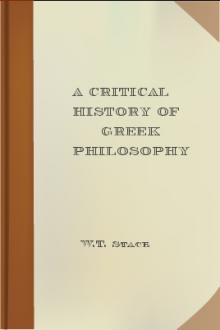A History of Indian Philosophy, Vol. 1 by Surendranath Dasgupta (desktop ebook reader txt) 📕

- Author: Surendranath Dasgupta
- Performer: -
Book online «A History of Indian Philosophy, Vol. 1 by Surendranath Dasgupta (desktop ebook reader txt) 📕». Author Surendranath Dasgupta
480
a necessary postulate of our phenomenal experience and unreal in its own nature, for apart from its connection with consciousness it is incomprehensible and undefinable. Its forms even while they are manifested in consciousness are self-contradictory and incomprehensible as to their real nature or mutual relation, and comprehensible only so far as they are manifested in consciousness, but apart from these no rational conception of them can be formed. Thus it is impossible to say anything about the ajñâna (for no knowledge of it is possible) save so far as manifested in consciousness and depending on this the D@r@s@tis@r@s@tivâdins asserted that our experience was inexplicably produced under the influence of avidyâ and that beyond that no objective common ground could be admitted. But though this has the general assent of Vedânta and is irrefutable in itself, still for the sake of explaining our common sense view (pratikarmavyavasathâ) we may think that we have an objective world before us as the common field of experience. We can also imagine a scheme of things and operations by which the phenomenon of our experience may be interpreted in the light of the Vedânta metaphysics.
The subject can be conceived in three forms: firstly as the âtman, the one highest reality, secondly as jîva or the âtman as limited by its psychosis, when the psychosis is not differentiated from the âtman, but âtman is regarded as identical with the psychosis thus appearing as a living and knowing being, as jîvasâk@si or perceiving consciousness, or the aspect in which the jîva comprehends, knows, or experiences; thirdly the anta@hkara@na psychosis or mind which is an inner centre or bundle of avidyâ manifestations, just as the outer world objects are exterior centres of avidyâ phenomena or objective entities. The anta@hkara@na is not only the avidyâ capable of supplying all forms to our present experiences, but it also contains all the tendencies and modes of past impressions of experience in this life or in past lives. The anta@hkara@na is always turning the various avidyâ modes of it into the jîvasâk@si (jîva in its aspect as illuminating mental states), and these are also immediately manifested, made known, and transformed into experience. These avidyâ states of the anta@hkara@na are called its v@rttis or states. The specific peculiarity of the v@rttiajñânas is this that only in these forms can they be superimposed upon pure consciousness, and thus be interpreted as states of consciousness and have their indefiniteness or cover removed. The
481
forms of ajñâna remain as indefinite and hidden or veiled only so long as they do not come into relation to these v@rttis of anta@hkara@na, for the ajñâna can be destroyed by the cit only in the form of a v@rtti, while in all other forms the ajñâna veils the cit from manifestation. The removal of ajñâna-v@rttis of the anta@hkara@na or the manifestation of v@rtti-jñâna is nothing but this, that the anta@hkara@na states of avidyâ are the only states of ajñâna which can be superimposed upon the self-luminous âtman (adhyâsa, false attribution). The objective world consists of the avidyâ phenomena with the self as its background. Its objectivity consists in this that avidyâ in this form cannot be superimposed on the self-luminous cit but exists only as veiling the cit. These avidyâ phenomena may be regarded as many and diverse, but in all these forms they serve only to veil the cit and are beyond consciousness. It is only when they come in contact with the avidyâ phenomena as anta@hkara@na states that they coalesce with the avidyâ states and render themselves objects of consciousness or have their veil of âvara@na removed. It is thus assumed that in ordinary perceptions of objects such as jug, etc. the anta@hkara@na goes out of the man's body (s'arîramadhyât) and coming in touch with the jug becomes transformed into the same form, and as soon as this transformation takes place the cit which is always steadily shining illuminates the jug-form or the jug. The jug phenomena in the objective world could not be manifested (though these were taking place on the background of the same self-luminous Brahman or âtman as forms of the highest truth of my subjective consciousness) because the ajñâna phenomena in these forms serve to veil their illuminator, the self-luminous. It was only by coming into contact with these phenomena that the anta@hkara@na could be transformed into corresponding states and that the illumination dawned which at once revealed the anta@hkara@na states and the objects with which these states or v@rttis had coalesced. The consciousness manifested through the v@rttis alone has the power of removing the ajñâna veiling the cit. Of course there are no actual distinctions of inner or outer, or the cit within me and the cit without me. These are only of appearance and due to avidyâ. And it is only from the point of view of appearance that we suppose that knowledge of objects can only dawn when the inner cit and the outer cit unite together through the anta@hkara@nav@rtti, which makes the external objects
482
translucent as it were by its own translucence, removes the ajñâna which was veiling the external self-luminous cit and reveals the object phenomena by the very union of the cit as reflected through it and the cit as underlying the object phenomena. The pratyak@sa-pramâ or right knowledge by perception is the cit, the pure consciousness, reflected through the v@rtti and identical with the cit as the background of the object phenomena revealed by it. From the relative point of view we may thus distinguish three consciousnesses: (1) consciousness as the background of objective phenomena, (2) consciousness as the background of the jîva or pramâtâ, the individual, (3) consciousness reflected in the v@rtti of the anta@hkara@na; when these three unite perception is effected.
Pramâ or right knowledge means in Vedânta the acquirement of such new knowledge as has not been contradicted by experience (abâdhita). There is thus no absolute definition of truth. A knowledge acquired can be said to be true only so long as it is not contradicted. Thus the world appearance though it is very true now, may be rendered false, when this is contradicted by right knowledge of Brahman as the one reality. Thus the knowledge of the world appearance is true now, but not true absolutely. The only absolute truth is the pure consciousness which is never contradicted in any experience at any time. The truth of our world-knowledge is thus to be tested by finding out whether it will be contradicted at any stage of world experience or not. That which is not contradicted by later experience is to be regarded as true, for all world knowledge as a whole will be contradicted when Brahma-knowledge is realized.
The inner experiences of pleasure and pain also are generated by a false identification of anta@hkara@na transformations as pleasure or pain with the self, by virtue of which are generated the perceptions, "I am happy," or "I am sorry." In continuous perception of anything for a certain time as an object or as pleasure, etc. the mental state or v@rtti is said to last in the same way all the while so long as any other new form is not taken up by the anta@hkara@na for the acquirement of any new knowledge. In such case when I infer that there is fire on the hill that I see, the hill is an object of perception, for the anta@hkara@na v@rtti is one with it, but that there is fire in it is a matter of inference, for the anta@hkara@na v@rtti cannot be in touch with the fire; so in the same experience there may be two modes of
483
mental modification, as perception in seeing the hill, and as inference in inferring the fire in the hill. In cases of acquired perception, as when on seeing sandal wood I think that it is odoriferous sandal wood, it is pure perception so far as the sandal wood is concerned, it is inference or memory so far as I assert it to be odoriferous. Vedânta does not admit the existence of the relation called samavâya (inherence) or jâti (class notion); and so does not distinguish perception as a class as distinct from the other class called inference, and holds that both perception and inference are but different modes of the transformations of the anta@hkara@na reflecting the cit in the corresponding v@rttis. The perception is thus nothing but the cit manifestation in the anta@hkara@na v@rtti transformed into the form of an object with which it is in contact. Perception in its objective aspect is the identity of the cit underlying the object with the subject, and perception in the subjective aspect is regarded as the identity of the subjective cit with the objective cit. This identity of course means that through the v@rtti the same reality subsisting in the object and the subject is realized, whereas in inference the thing to be inferred, being away from contact with anta@hkara@na, has apparently a different reality from that manifested in the states of consciousness. Thus perception is regarded as the mental state representing the same identical reality in the object and the subject by anta@hkara@na contact, and it is held that the knowledge produced by words (e.g. this is the same Devadatta) referring identically to the same thing which is seen (e.g. when I see Devadatta before me another man says this is Devadatta, and the knowledge produced by "this is Devadatta" though a verbal (s'âbda) knowledge is to be regarded as perception, for the anta@hkara@na v@rtti is the same) is to be regarded as perception or pratyak@sa. The content of these words (this is Devadatta) being the same as the perception, and there being no new relationing knowledge as represented in the proposition "this is Devadatta" involving the unity of two terms "this" and "Devadatta" with a copula, but only the indication of one whole as Devadatta under visual perception already experienced, the knowledge proceeding from "this is Devadatta" is regarded as an example of nirvikalpa knowledge. So on the occasion of the rise of Brahma-consciousness when the preceptor instructs "thou art Brahman" the knowledge proceeding from the sentence is not savikalpa, for
484
though grammatically there are two ideas and a copula, yet from the point of view of intrinsic significance (tâtparya) one identical reality only is indicated. Vedânta does not distinguish nirvikalpa and savikalpa in visual perception, but only in s'âbda perception as in cases referred to above. In all such cases the condition for nirvikalpa is that the notion conveyed by the sentence should be one whole or one identical reality, whereas in savikalpa perception we have a combination of different ideas as in the sentence, "the king's man is coming" (râjapuru@sa âgacchatî). Here no identical reality is signified, but what is signified is the combination of two or three different concepts [Footnote ref 1].
It is not out of place to mention in this connection that Vedânta admits all the six pramâ@nas of Kumârila and considers like Mîmâ@msâ that all knowledge is self-valid (svat@ah-pramâ@na). But pramâ has not the same meaning in Vedânta as in Mîmâ@msâ. There as we remember pramâ meant the knowledge which goaded one to practical action and as such all knowledge was pramâ, until practical experience showed the course of action in accordance with which it was found to be contradicted. In Vedânta however there is no reference to action, but pramâ means only uncontradicted cognition. To the definition of self-validity as given by Mîmâ@msâ Vedânta adds another objective qualification, that such knowledge can have svata@h-prâmâ@nya as is not vitiated by the presence of any do@sa (cause of error, such as defect of senses or the like). Vedânta of course does not think like Nyâya that positive conditions (e.g. correspondence, etc.) are necessary for the validity of knowledge, nor does it divest knowledge of all qualifications like the Mîmâ@msists, for whom all knowledge is self-valid as such. It adopts a middle course and holds that absence of do@sa is a necessary condition for the self-validity of knowledge. It is clear that this is a compromise, for whenever an external condition has to be admitted, the knowledge cannot be regarded as self-valid, but Vedânta says that as it requires only a negative condition for the absence of do@sa, the objection does not apply to it, and it holds that if it depended on the presence of any positive condition for proving the validity of knowledge like the Nyâya, then only its theory of self-validity would have been damaged. But since it wants only a negative condition, no blame can be
____________________________________________________________________
[Footnote 1: See Vedântaparibhâ@sâ and S'ikhâma@ni.]
485
attributed to its theory of self-validity. Vedânta was bound to follow this slippery middle course, for it could not





Comments (0)